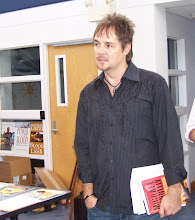
Some people just know how to make an entrance.
Jill and Kevin do.
If you haven’t seen their wedding entrance, you should. Go here to view it: http://www.youtube.com/watch?v=4-94JhLEiN0 and become 1 of over 11 million who have watched it in its first week of existence.
I’ve watched it a dozen times already—and each and every one I laugh and I cry simultaneously.
Why have over 11 million people watched Jill and Kevin and their wedding party march down the aisle? Why have I (and so many others) watched it over and over again? Why did it bring a smile to my face even as it brought tears to my eyes?
Perhaps partly because the best things online, from how-to videos to advice columns, from parodies to porn, involve amateurs—DIYs, poets, independent artists, and stay-at-home-moms who now have a means to share their ideas, their work, themselves.
Professionals do it for money, but amateurs do it for love.
A professional is someone who makes a living doing what they do, an amateur is someone who loves it so much they live to do it.
As a writer, I’ve always attempted to be a professional-amateur—striving for the skill, and knowledge, expertise, and experience of a professional, yet having love as my primary if not only motivation. I write because I love to, and I write about what I love (and I love Jill and Kevin and their friends!).
There’s not a professional dancer among them, and there are only a few decent ones. And that’s what makes it so moving, so powerful, such a You Tube phenomenon.
We’d expect to see art students or professional performers dance their way down the aisle of a nonreligious venue they were getting married in, but for average Jills and Joes to dance down the aisle of a church as part of what looks to be a fairly traditional wedding . . . It’s not just unexpected, it’s refreshingly authentic.
Give me genuine actions over polished performances any day.
But that’s only part of the reason this five minute video has become the most popular clip flying through cyber space at the moment.
Another reason? Friends.
Having friends to stand with us during the momentous or difficult days of our lives is something we all deeply and desperately need (and increasingly don’t have), but to have ones who will dance with us—what could be better? What is a friend after all, but someone who cares enough for us to weep when we weep, dance when we dance?
I try to be the kind of friend who will gladly dance down the aisle of life with others, and am constantly looking for friends who will do the same. They are not easy to find—Jill and Kevin are truly blessed.
I suspect yet another reason the video has become so popular is the song.
Let me be clear, I don’t think a woman should be with a man who hits her—not even one time (and it’s never just one time), and I will not be buying any more of Chris Brown’s music. A man who would beat a woman—any person who would use their relative power, be it physical or otherwise to impose his or her will, has lost the best part of their humanity and needs treatment not a world tour. That said, art transcends the artist in the way truth transcends the flawed vessel it’s poured through, and the song was an excellent choice for a young couple dancing down the aisle together.
It's you and me moving
At the speed of light into eternity yea,
Tonight is the night to join me in the middle of ecstasy.
Feel the melody in the rhythm of the music around you, around you
It’s like I’ve waited my whole life for this one night
It’s gonna be me you and the dance floor
’cause we've only got one night (one night)
Double your pleasure
Double your fun and dance
Forever (ever, ever)
Some people really do seem to see marriage as the “one night” they wait their whole lives for—anticipate, long for, feel less than without. And though marriage began as a sexist institution for men to protect their property (which included their wives) and has become a prison of culture and a weapon of exclusion, it’s still possible for good, healthy, relationships to exist within it in spite of all this, in the same way humble, honorable, compassionate, there-for-the-right-reasons people are present in the flawed and broken institutions of religion. I hope Jill and Kevin have an empowering union that supports each of them in becoming their best selves. They appear to be off to a good start.
Finally, I think the video has become so popular because it involves dancing.
Dancing does something for our species that nothing else can. It’s primal and comes from the deep soul, and in the industrialized, post-modern West, we don’t do it enough. Sure we have dance as seduction, as sex with clothes on, and there’s certainly a place for that. We have Dancing with the Stars and overly choreographed, overly structured dancing in certain places at certain times. We have dancing for others—demonstrating moves to impress or woo, but what about just dancing to dance—dancing because we are alive and few things feel as alive as feeling rhythm in our souls and expressing it through our bodies. Losing ourselves in something as spiritual and magical as music and dance is truly transcendent. But that’s the key—losing that sense of self (and the self-consciousness it causes) in becoming one with the beat, the group, the world. Kevin and Jill and their friends may have been self-conscious and part of what they were doing may have had elements of performance, but most of it appears to be pure joy, caught up in the moment, being a good friend, being a—just being.
When I dance, which is often and often alone, it’s because I’m experiencing something I can’t contain, and when I do, I join the rocking rhythm of the undulating universe, whose strings are in constant creative motion, and in some mysterious way I’m joining all dancers—from King David of Israel to Michael Jackson to ancient indigenous tribes in Africa to as beautiful a bride as there has ever been, Jill, in a cosmic chorus that is primal, communal, sacred. Why not join us? At this very moment life is saying to you, May I have this dance?
















